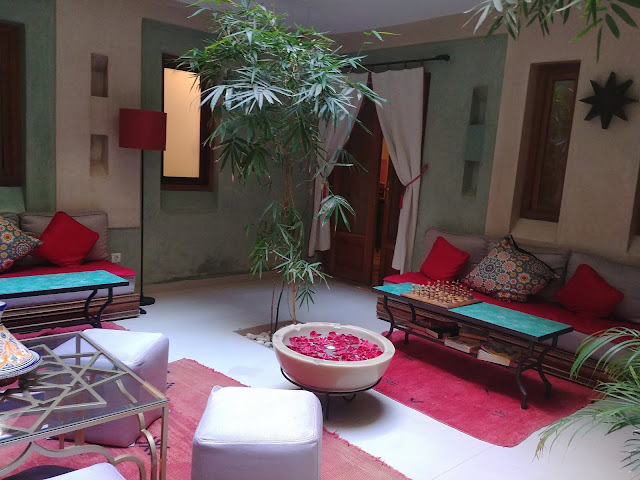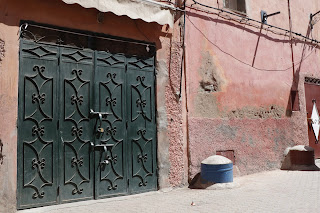Morocco….. Land of Kasbahs and Medinas
Some people asked why we added Morocco on to a trip to Egypt. It is not exactly next door and the connecting flights do not work well. It is about 5 hours from Cairo to Casablanca and another 2 1/2 hour drive to Marrakech where we were headed.
But Morocco just sounds so exotic and Arabic. I picture sultan’s palaces, flying carpets and genies in a bottle. And just the sound of Kasbah and Medina and Souk are intriguing. And how can places with names like Casablanca and Marrakech not be fabulous? So, why not?
We land in Casablanca. My first impression from the air is how agricultural it is around Casablanca. Orderly green fields surround the city where I imagined only deserts. We later learned that when the rest of the area was developing resources like oil and gas Morocco chose instead to focus on agriculture and base its economy on that. The government (Kingdom) has invested in dams and irrigation and crop development.
Morocco is now a leading producer and exporter of olives, dates, sugar, watermelon, oranges. And the sole producer of Argan oil, made from the nut of the Argan tree that grows only in a very specific area of the country. Plus they grow wheat, barley and vegetables mostly for their own population, reducing their dependence on other countries.
The High Atlas Mountains run through Morocco, getting snow and rain which feeds the rivers. Dams manage the water supply and deliver water to verdant oases where groves of dates and olives thrive.
But what about their need for fuel if they do not develop those resources which surely lie under their lands as well? Morocco is committed to developing solar and wind power and is one of the leaders in that field, currently developing what will be one of the largest solar farms in the world. It is their goal to provide 40% of all the power they consume from solar by 2030. And why not, where would you get more hours of sun… how smart is that.
I was very impressed by the forward thinking and strategic approach they are taking in many ways. Of course there is still a long way to go in areas like recycling and water quality and things like that. But they are aware and taking proactive steps. The city of Casablanca has implemented a recycling program and even Marrakech has recognized the problem with plastics and banned single use plastic bags. Whenever you buy something it is provided in a small resuable bag.
Marrakech…
Our Riad or hotel is located inside the Medina which is the old walled city dating back centuries. Winding cobblestone alleyways weave their way through the medina. Luckily our guide is leading the way and we follow. You can not drive in so our bags are loaded into a cart which is pulled in by a porter for a few dirham. The alleys are dusty and narrow. Brahim, our guide, challenges us to remember how we got to the Riad and see if we can figure out how to get back out. Left, left, right,left…. We are a bit nervous of getting lost in this maze.
The Riad l’Huere d’Ete is small, only 11 units. Like all legitimate Riads the rooms open to a central tiled courtyard. Riads are typically old homes within the medina that have now been converted into small hotels. They always have the central courtyard or garden, typically a rooftop patio with a pool or hottub, often a spa or hammam and a restaurant of some type. If you are lucky you may be able to get a cold beer or glass of wine but Morocco is 98% muslim and alcohol is hard to find.
Our Riad was positioned on its website as 4 ½ stars. That was generous. But we came to enjoy it. The rooms were spacious and the air conditioning was working overtime to combat the 42 degree weather. The shower left something to be desired and it was a bit tired and dated but located well and quite comfortable. And the internet, though free, was a challenge.
Walking tour….
The Medina is the old area of Marrakesh. The newer area outside the walls is modern and very influenced by the French who occupied Morocco from 1912 to 1956. It feels prosperous and optimistic with many new office buildings and businesses. North American and European stores and fast food restaurants are evident, even Starbucks. No building can be over 5 storeys high.
But the medina retains its old world feel. In the centre is the square, Jemaa el Fna. This is the heart of the medina. Restaurants and little shops surround it and in the evening it comes alive with stalls selling everything from oranges and fruits to colorful scarves and lanterns. You can get Henna tattoos or watch jugglers or acrobats or monkeys. If you go early to one of the rooftop patios you can catch a spectacular sunset as you cool down with a cold Coke or Sprite or water… likely not anything alcoholic though.
There is music and chanting and dancing in the square. It is a gathering place where African culture mixes with Arabic and tourists from all corners of the world join in. But at 9:00 you will see the exodus as the Muslims make their way to the mosque.
From the square, follow through the ancient stone archway into the old alleyway, El Waha, lined with little shops selling all manner of souvenirs, pottery, lanterns, wooden carved camels, and any other Moroccan item you may fall in love with. Beautiful little tea glasses (they drink tea out of small glasses not cups), colorful scarves and loose cotton tops ideal for the heat. Colorful Moroccan slippers, hats, cushions, etc…….
The alley is narrow and crowded. You must be alert. Motorcycles or scooters whiz through pushing everyone to the side. Every now and then a tuk-tuk or a donkey cart carrying a load of something will make its way through. People scramble out of the way then continue on.
And the doors….. Moroccan people take their doors very seriously. Even the most run down place has a great door. Whether it is heavy ornately carved wood or colorful iron doors or hand painted designs, doors are special and unique… and photographic!
Being almost entirely Muslim, of course the mosque is a critical part of the Moroccan culture. Muslim people must pray 5 times a day and whenever possible they do this at their mosque. The mosque itself overflows and people gather in the courtyard around the mosque. Many bring their own mat for kneeling, other use the straw mats provided. One of the key elements is that everyone is equal and so they fall into place next to the last person, no place of privilege or status.
The tall minaret hosts 3 bronze balls- the largest represents Mecca – their Holy Land; the second is Medina, another Holy place; and the third is for Jerusalem. These are the three most sacred places. First prayer is just before sunrise and last is just after sunset.
A man whose job it is calls people to prayer through a loud speaker system that carries through the medina. You will see people in the square, in their pace of business, participating in the prayer. Because it was Ramadan when we were there the people are not allowed to eat or drink anything from sunrise (about 4:30) to sunset (7:20). Nothing – not even water. Bear in mind the temperatures. From 7:00 to 8:00 many businesses close so the people can break their fast with sweet sugary pastries, juices and then a meal and water.
At the other end of the medina is a huge stone archway, it is the entryway into the Kasbah. The Kasbah traditionally was the palace or home of the Sultan. It lay within the medina, another walled section within the walls of the medina. Now it just holds more shops and restaurants. There is also the Jewish quarter where the Jewish people lived from about the 16th century until they were forced out to return to Israel. There are very few Jewish people left but that is where th
 e best markets or souks are – wonderful spice markets with heaping colored
bins of every exotic spice you could imagine – brilliant orange saffron,
fragrant rosemary, fresh mint and oregano.
e best markets or souks are – wonderful spice markets with heaping colored
bins of every exotic spice you could imagine – brilliant orange saffron,
fragrant rosemary, fresh mint and oregano.
The Bahia Palace is also within the medina. It dates back to 1860 and was the residence and office of the Grand Vizier, or Prime Minister under the King.
He wanted the power so when the king died he bypassed the elder sons and had the youngest song named king. The son was only 12 so he assumed power and ran the country and built himself this magnificent palace, in which he housed not only his 4 wives but also his 24 concubines.
One area of the palace is the Harem where the concubines resided. There was also a school for all of his children – not sure how many there were. It is a magnificent building all spread out over one floor. The Grand Vizier demanded the palace have no more than 3 steps in any place. That is because he was very short and fat and could not handle more than 3 steps.
There are beautiful courtyards and gardens and fountains as well as his offices and important meeting rooms.

The weather is very hot and even more so in the medina where the heat reflects off the stone walls. By the end of the day the sweat is dripping. The only place we know that can offer a nice cold beer is the Tazi Bar, so that where we head to cool down before returning to our Riad.
























No comments:
Post a Comment